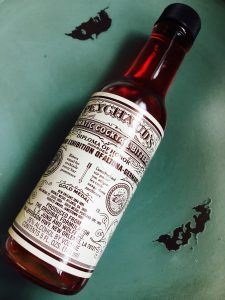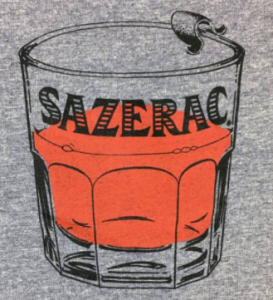Include a Topper!
-
Happy Birthday Banner
$9.00 -
Gingerbread Cake Topper
$15.00
Add Ons
Your cart is currently empty!
Since 1949 celebrating 75 years. Order online or call us at 1 800 GAMBINO (426-2466)


Born and bred in the Big Easy, the Sazerac is a cornerstone of drinking culture in the South. So much so, that it is often said to be the first cocktail ever made, a rumor that has graced New Orleanian lips since the early 1800’s. While the Sazerac holds a prominent place in our history and on bar tabs around the country, it unfortunately is not the world’s first cocktail. The rupture of this myth, however, doesn’t lessen the amazing New Orleans history that surrounds the drink itself.
A Pharmaceutical Start
The Sazerac’s story begins with a man named Antoine Amédée Peychaud, a Haitian native who immigrated to New Orleans at the start of the nineteenth century, seeking to build for himself a career in pharmaceuticals. His dreams were realized quickly, marked by the opening of ‘Pharmacie Peychaud’ on Royal Street in 1841. In the heart of what was then called the ‘Latin Quarter,’ Peychaud grew a successful drug store that aided patrons across New Orleans with herbal remedies to suit their ails. One such remedy, a calming cure-all, was a mixture that Peychaud had come up with himself: a combination of bitters (which would later be branded Peychaud’s Bitters) and cognac special imported from Limoges, France. It is this cognac that gives the dri

nk its name, as the brand that Peychaud used was called Sazerac de Forge-et-Fils.
Peychaud served this concoction in a small egg shaped cup, known to the French as a coquetier. This small cup helped to fuel the rumor of Peychaud’s drink being the first cocktail. It is falsely considered that the Anglicized pronunciation of coquetier originated the word cocktail; in truth, however, the word cocktail made its first appearance in newspapers long before Peychaud had even made it to New Orleans. Nonetheless, his patrons became increasingly infatuated with the drink, so much so that Peychaud began to see profit in it.
Peychaud became familiar with a man named Sewell Taylor who owned the cafe next door, named the Merchant’s Exchange Coffee House. After much discussion, Peychaud decided to sell his recipe to Taylor, who began to sell the cocktail fervently. Taylor brought along the Sazerac’s first change by adding sugar and a splash of absinthe to the previously simple mixture. Though Taylor enhanced the recipe, he remained loyal to its original brands, using only Peychaud’s bitters and Sazerac de Forge-et-Fils. The ‘new’ Sazerac’s success was immense, and the Merchant Exchange soon became the Sazerac Coffee House.
From French Influence to American Made
A blight in France in the 1890’s brought on the Sazerac’s next change. The mass damage to the crops across the French countryside impacted the production of brandies and restricted the import of French alcohols, making Sazerac de Forge-et-Fils all but unattainable. In an attempt to focus locally, the Sazerac Coffee House replaced the cognac with American-made rye whiskey. Though drastic, this change again brought only success for the Sazerac, making it even more desirable to its vast consumers.
The Birth of the Sazerac Company
In the late 1800’s the coffee house business was purchased by a man named C.J. O’Reilly. He quickly rebranded it as the Sazerac Company and simultaneously launched his American-made whiskey by the same name. Which brings us one step closer to the Sazerac we recognize today. Where it began as a French cognac, transformed into a coffee house, and evolved into a cocktail with a different set of ingredients, today we understand Sazerac to be both the drink and the brand of whiskey it contains.
Of course there is one more change to be made, as we all know absinthe quickly became illegal at the turn of the twentieth century, making the Sazerac incomplete. Over the years a number of replacements were sought, various anise flavored liqueurs were added to fill the space that absinthe left, but none stuck. It wasn’t until 1943 that the Sazerac found its newest addition when a man named Marion J. Legendre developed a liqueur that mimicked the taste of absinthe without the wormwood that would make it illegal. He called it Herbsaint. Herbsaint was used profusely in conjunction with the Sazerac’s other ingredients, enough so that in 1949 the Sazerac Company acquired the brand and made it an official part of the Sazerac recipe.
These changes bring us to today’s Sazerac, whose official recipe consists of sugar, Peychaud’s bitters, Sazerac rye whiskey, and a dash of Herbsaint. The Sazerac Company itself continued to grow and now exists as the largest distilling company in the United States. They distill a number of American-made alcohols, ranging from rum to vodka, gin to tequila, and of course their original star: rye whiskey. They also make Buffalo Trace Bourbon, which, if you’re feeling fancy, can serve as a replacement for the whiskey in a Sazerac.
A New Orleans Classic
We remain devoted to the Sazerac here in New Orleans, having made it our city’s official cocktail in 2008—as decided by the Louisiana House of Representatives—and proudly serve it in establishments across the Big Easy. The French Quarter’s Roosevelt Hotel even houses the Sazerac Bar — which is said to be where the Ramos Gin Fizz was invented, but that is a story for another time. So while it may not be the world’s first cocktail, it most certainly is New Orleans’ best, with a history as transformative as the city itself, and as wildly delicious, too.